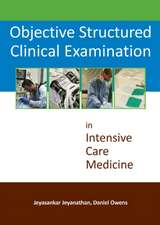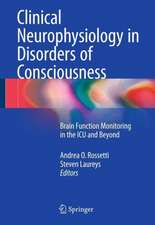Infection Control in Intensive Care Units by Selective Decontamination: The Use of Oral Non-Absorbable and Parenteral Agents: Update in Intensive Care and Emergency Medicine, cartea 7
Editat de Hendrik K. F. van Saene, C. P. Stoutenbeek, Peter Lawin, I. McA. Ledinghamen Limba Engleză Paperback – 17 mar 1989
Din seria Update in Intensive Care and Emergency Medicine
- 5%
 Preț: 735.83 lei
Preț: 735.83 lei - 5%
 Preț: 408.44 lei
Preț: 408.44 lei - 5%
 Preț: 713.33 lei
Preț: 713.33 lei - 5%
 Preț: 723.42 lei
Preț: 723.42 lei - 5%
 Preț: 722.69 lei
Preț: 722.69 lei - 5%
 Preț: 738.06 lei
Preț: 738.06 lei - 5%
 Preț: 725.24 lei
Preț: 725.24 lei - 5%
 Preț: 376.22 lei
Preț: 376.22 lei - 5%
 Preț: 724.70 lei
Preț: 724.70 lei - 5%
 Preț: 731.64 lei
Preț: 731.64 lei - 5%
 Preț: 723.78 lei
Preț: 723.78 lei - 5%
 Preț: 724.50 lei
Preț: 724.50 lei - 15%
 Preț: 589.95 lei
Preț: 589.95 lei - 5%
 Preț: 369.84 lei
Preț: 369.84 lei - 5%
 Preț: 715.35 lei
Preț: 715.35 lei - 5%
 Preț: 711.52 lei
Preț: 711.52 lei - 5%
 Preț: 724.14 lei
Preț: 724.14 lei - 5%
 Preț: 730.92 lei
Preț: 730.92 lei - 5%
 Preț: 375.34 lei
Preț: 375.34 lei - 5%
 Preț: 710.43 lei
Preț: 710.43 lei - 5%
 Preț: 367.84 lei
Preț: 367.84 lei - 5%
 Preț: 716.65 lei
Preț: 716.65 lei - 5%
 Preț: 378.97 lei
Preț: 378.97 lei - 5%
 Preț: 374.20 lei
Preț: 374.20 lei - 5%
 Preț: 1108.72 lei
Preț: 1108.72 lei - 5%
 Preț: 717.37 lei
Preț: 717.37 lei - 5%
 Preț: 2433.95 lei
Preț: 2433.95 lei - 5%
 Preț: 2680.79 lei
Preț: 2680.79 lei - 5%
 Preț: 2111.90 lei
Preț: 2111.90 lei - 5%
 Preț: 404.54 lei
Preț: 404.54 lei - 5%
 Preț: 726.68 lei
Preț: 726.68 lei - 5%
 Preț: 740.58 lei
Preț: 740.58 lei - 5%
 Preț: 717.73 lei
Preț: 717.73 lei
Preț: 715.35 lei
Preț vechi: 753.01 lei
-5% Nou
Puncte Express: 1073
Preț estimativ în valută:
136.88€ • 142.93$ • 113.03£
136.88€ • 142.93$ • 113.03£
Carte tipărită la comandă
Livrare economică 15-29 aprilie
Preluare comenzi: 021 569.72.76
Specificații
ISBN-13: 9783540510413
ISBN-10: 3540510419
Pagini: 252
Ilustrații: XV, 235 p. 5 illus.
Dimensiuni: 170 x 244 x 13 mm
Greutate: 0.41 kg
Editura: Springer Berlin, Heidelberg
Colecția Springer
Seria Update in Intensive Care and Emergency Medicine
Locul publicării:Berlin, Heidelberg, Germany
ISBN-10: 3540510419
Pagini: 252
Ilustrații: XV, 235 p. 5 illus.
Dimensiuni: 170 x 244 x 13 mm
Greutate: 0.41 kg
Editura: Springer Berlin, Heidelberg
Colecția Springer
Seria Update in Intensive Care and Emergency Medicine
Locul publicării:Berlin, Heidelberg, Germany
Public țintă
ResearchCuprins
Foreword.- One: Pathogenesis.- Host-microorganism Relationship in Healthy People.- Classification of Microorganisms Based on Intrinsic Pathogenicity.- Defence Against Colonization and Infection.- Oropharyngeal/Gastrointestinal Carriage: Role in Endogenous Colonization and Infection.- Discussion.- Host-microorganism Relationship in the Critically Ill.- Impaired Colonization Defence of the Oropharynx.- Impairment of Defence of the Stomach and Intestine against Colonization in the Critically Ill Patient.- Pathogenesis of Colonization/Infection of Lower Airways (Endogenous vs Exogenous): Conventional Approaches to Infection Control.- Discussion.- Two: The Conventional Approach to Infection Control.- Clinical Studies.- Prospective Study of Colonization, Infection and Mortality Rates during Conventional Therapy: Glasgow Data.- Infection and Mortality Rates in Critically Ill Patients during Conventional Antibiotic Regimen.- A Prospective Study of Colonization and Infection in the Neonatal Surgical Unit at Alder Hey Children’s Hospital, Liverpool, UK.- Surveillance of Nosocomial Infections in a Surgical ICU: A Prospective Study.- Prospective Study of Colonization, Infection and Mortality Rates during Conventional Therapy.- Infection Control in the ICU: Pattern of Colonization and Infection in Surgical Intensive Care Patients — a Prospective Study.- Discussion.- Antibiotic Resistance.- Where and How does Antimicrobial Resistance Develop in the Critically Ill? Studies in Neonatal Patients.- Do Conventional Policies Control Antibiotic-resistant Bacteria?.- Discussion.- Three: An Alternative Approach — Selective Decontamination of the Digestive Tract (SDD); the Use of Non-absorbable and Parenteral Agents.- Philosophy of SDD.- Concept of Selective Decontamination in theCritically Ill.- Topical Antibiotic Regimen.- Use of a Short-term Parenteral Antibiotic as a Supplement to SDD.- Pharmaceutical Technology, in Selective Decontamination.- Discussion.- Clinical Studies.- Prospective Study of Colonization, Infection and Mortality in ICU Patients Treated with SDD and Systemic Cefotaxime: Glasgow Results.- Prospective Study of Mortality Rates in Critically Ill Patients During SDD Regimen.- Prospective Studies of Colonization, Infection and Mortality Rates: Liverpool Data.- Infection Control by Selective Flora Suppression in Critically Ill Patients.- Prospective Studies of Colonization, Infection and Mortality Rates in ICU Patients Receiving SDD: Ulm Results.- Prevention of Colonization and Subsequent Infection in Critically Ill Patients: a Prospective, Randomized Study.- The Effect of a Novel Regimen of Selective Decontamination on the Incidence of Unit-Acquired Lower Respiratory Tract Infection in Mechanically Ventilated Patients.- Discussion.- Role of Endotoxin.- Significant Reduction of Faecal Endotoxin Pool by Oral Polymyxin E and Tobramycin in Human Volunteers.- Endotoxaemia in Multiple Organ Failure: A Secondary Role for SDD?.- Discussion.- Emergence of Resistance during SDD.- Cefotaxime Combined with Selective Decontamination in Long-Term Intensive Care Unit Patients: Virtual Absence of Emergence of Resistance.- Emergence of Resistance During Selective Decontamination: Glasgow Results.- Changes in Antibiotic Resistance in Tracheal Aspirates Following Selective Decontamination of the Digestive Tract.- The Liverpool Experience, 1987–1988.- Colonization and Resistance Patterns of Microbial Isolates Following SDD in Association with Short-Course Cefotaxime.- Gram-negative Bacillary Resistance in a Surgical Intensive Care Unit: AFour-Year Surveillance.- Discussion.- Four: Stress Ulcer Prophylaxis and Pneumonia.- Stress Ulcer Prophylaxis and Pneumonia.- Pathogenesis of Stress Ulcer Bleeding in the Critically Ill.- Gastric Colonization and Nosocomial Pneumonia in the Mechanically Ventilated Patient.- New Approaches to the Prevention of Infection in Intensive Care Unit Patients.- Discussion.- Five: Analysis of Conventional and SDD Approaches.- A Possible Explanation for the Success of SDD.- Discussion.- Impact of Parenteral Cephalosporins on Human Oropharyngeal and Faecal Flora.- Discussion.- Development of Antibiotic Resistance During Conventional and SDD.- The Gut and Sepsis in the Critically Ill.- Discussion.- Conclusions.- Close.- Appendices.- Appendix I: Formulations Used in Selective Decontamination.- Appendix II: List of Abbreviations.- Appendix III: Trials of Infection Rates Following Conventional Treatment and Selective Decontamination.












